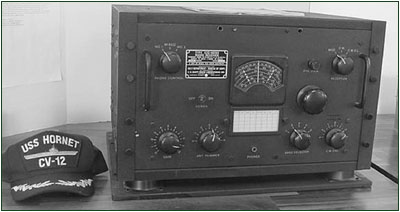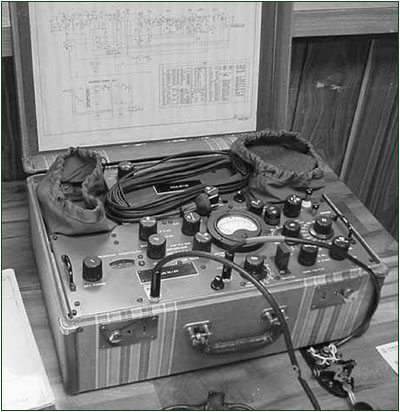Of Old Radios And Related Items--Published Monthly
Military Radio Collectors Group Annual Meet
Camp San Luis Obispo, Calif. April 30-May 1, 2004REPORTED BY HANK BROWN
Web Edition
A.R.C. has covered the MRCG's annual meets for several years. In this article, Hank Brown describes the group's hands-on activities and includes photographs and descriptions of military gear from the past. (Editor)
This year the Military Radio Collectors Group (MRCG) returned to Camp San Luis Obispo (SLO) for its ninth annual meet, April 3 to May 1. The two previous meets had been held at Fort MacArthur in San Pedro because of security concerns at SLO after the 9/11 tragedy. The gate at SLO is now guarded, and all persons must show a driver's license, valid registration, and proof of vehicle insurance.
The required documentation was submitted in advance on the camp's Web site to minimize delays at the gate. Though the guards took a good look at all the documents, they did not question or look into any of the vehicles loaded with tons of equipment from World War II to the present. Departing the site was also very easy -- we just drove through the gate.
Meet Conditions and Activities
The weather was excellent throughout the meet. Most of the operators noted that the radio noise level was much lower than two years ago. These good conditions allowed for some long distance contacts with the high frequency (HF) sets and larger antennas up in trees.
Friday started off with a busy registration desk and lots of equipment being set up inside the NCO Club. Brooke Clark was the first speaker and presented an excellent overview of the PRC-68 family of radios. These small hand-held units operate in the VHF range.
Bjorn Forsberg followed Brooke with an excellent presentation on his R.1155 receiver used in the Lancaster 4-engine bomber. The receiver is all original and came from an aircraft museum in England. His radio and a BC-340 are shown in the above photo.
Bill Feldman described his experiences restoring BC-610 transmitters, and he offered solutions for getting these rigs working again. The BC-610 is a large unit used by the Army during World War II in high-powered, truck-mounted, mobile radio stations. The complete station, the SCR-299, used two receivers, a transmitter, antennas, an antenna tuner, a power supply, field telephones, reels of wire, and a stock of spare parts and tools.
The Friday lunch BBQ was served by Wild Bill. Bill is familiar with Camp SLO, having catered to several organizations meeting at the camp over the years.
We usually schedule the Saturday morning swap meet from sunup to about 9 a.m. Before daylight, the second seller arrived and the meet was up and running. A large assortment of equipment, parts, manuals, tubes and accessories were offered. Many participants were thrilled to obtain the last part or item needed to complete a set on the bench.
Also available for sale was a large CD collection of manuals on military gear and a DVD on how production of the SCR-299 was accomplished during the war. Both items were moving well at reasonable prices.
Transmitter Hunt
The hidden transmitter hunt has always been a fun event, and this year was no exception. The plan was to conduct a hunt on 3,885 Kc with a small transmitter and conduct another hunt on 51 Mc FM with another small unit. However, there were no entries for 3,885 Kc so only the 51 Mc unit was used.
The first two hunts went well with just about everyone finding the elusive hidden signal source. For the third run, we decided to make things more interesting! The transmitter was set up inside a shoulder bag and given to one of the gentlemen wandering around the swap meet looking for goodies. The action was hilarious as the hunters got close to the unit.
When that happened, the gentleman would wander over to another table, and the hunters would be baffled. Several times, we saw two and three hunters with their loops head right for the shoulder bag and then keep going. On one occasion, four hunters with loops headed for the shoulder bag from all four directions at once. They all kept going and ended up at four distant points with the transmitter about in the middle of the square. Finally, two of the participants did indeed locate the hidden transmitter. There were many comments and smiles from all involved in this event.
Navy RCH or Scott SLR-F

This communications receiver was used on many Navy and Merchant ships from the 1940s to the 1950s. Low frequency tuning is from 85 Kc to 600 Kc and HF tuning from about 2 Mc to 18 Mc. The receiver is very well constructed with shielding around all components and compartments. The complete set in its cabinet and mount weighs over 100 pounds. Sensitivity is very good and rugged heavy construction provides excellent stability. Power input is 110 volts, 60-cycle AC. If a HF doublet-type antenna is employed on the top three bands, a switching circuit connects the antenna to the receiver as a "T" antenna on the two low frequency bands.AN/PRC-1 Transmitter/Receiver

Dick Dillman set up his PRC-1 "Suitcase" spy transmitter on 80 meters. This one is serial number 139 and tunes from 2 Mc to 12 Mc. The receiver employs five tubes while the transmitter output is close to 40 watts. Post 9/11, I doubt anyone could carry this "Suitcase" around as he or she did during World War II.Meet Highlight
A few months before this event, Don Taylor contacted MRCG and informed us that he had been at Camp SLO in 1940 and had operated the SCR-131 field radio in and around the camp. This information inspired a frenzy of activity, as several participants attempted to get their own SCR-131 radios in operational condition in time for the meet.
A total of three sets were set up and this in itself is probably a rare occurrence. Don Taylor had been invited to attend the meet and was able to operate one of the original sets and contact another operator on another original set just as they had done some 60 years ago. Of course, we just had to get some stories out of Don. Surely, this was the highlight of the 2004 meet.
Plans for the next meet will be announced around the first of the year. Watch the MRCG Web Site www.syzen.com/milradio/ for details.
(Hank Brown, Military Radio Collectors Group, 4141 West L-2, Lancaster, CA 93536)
| [Free Sample] [Books, etc., For Sale] [Subscribe to A.R.C./Renew] [Classified Ads] [Auction Prices] [Event Calendar] [Links] [Home] [Issue Archives] [Book Reviews] [Subscription Information] [A.R.C. FAQ] URL = http://www.antiqueradio.com/Nov04_Brown_milrad.html Copyright © 1996-2004 by John V. Terrey - For personal use only. Last revised: October 31, 2004. For Customer Assistance please contact ARC@antiqueradio.com or call (866) 371-0512 Pages designed/maintained by Wayward Fluffy Publications
Antique Radio Classified |